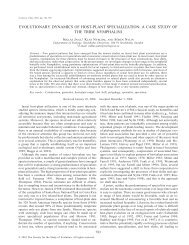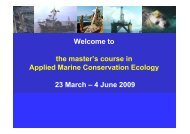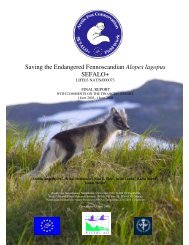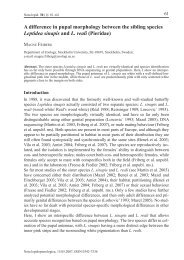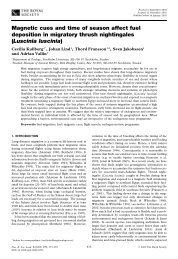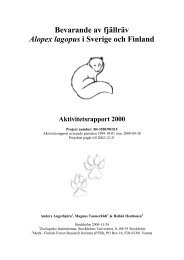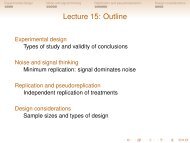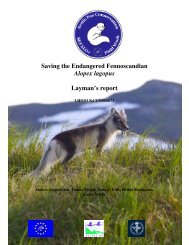The conservation of Fennoscandian arctic foxes - Stockholms ...
The conservation of Fennoscandian arctic foxes - Stockholms ...
The conservation of Fennoscandian arctic foxes - Stockholms ...
Create successful ePaper yourself
Turn your PDF publications into a flip-book with our unique Google optimized e-Paper software.
<strong>The</strong> <strong>conservation</strong> <strong>of</strong> <strong>Fennoscandian</strong> <strong>arctic</strong> <strong>foxes</strong>: the effects <strong>of</strong> supplementalfeeding and red fox hunting.Report from the SEFALO+ project LIFE03 NAT/S/000073Anders Angerbjörn 1 , Karin Norén 1 , Tomas Meijer 1Heikki Henttonen 2 , Matti Mela 2 , Nina E. Eide 3 , Arild Landa 3 , Peter Hellström 11 Zoologiska Institutionen, <strong>Stockholms</strong> Universitet (SU), S-106 91 Stockholm2 Metla –Finnish Forest Research Institute (FFRI), PO Box 18, FIN-01301 Vantaa3 Norwegian Institute for Nature Research (NINA), Tungasletta 2, N-7485 TrondheimDecember 2007
ABSTRACT<strong>The</strong> SEFALO+ project has focused on <strong>conservation</strong> actions to increase the viability <strong>of</strong> the threatened<strong>Fennoscandian</strong> <strong>arctic</strong> fox. But one <strong>of</strong> the tasks has also been to evaluate the effect <strong>of</strong> supplementaryfeeding and red fox culling for future management <strong>of</strong> the <strong>arctic</strong> fox population. Supplementary feedinghas been shown to have a positive effect on the number <strong>of</strong> litters and an increase in juvenile survival.In addition to this we have also found an increase in the litter sizes. However, supplementary feedingcan also have an attracting effect on the red fox and thereby have a negative effect on the <strong>arctic</strong> fox.Red <strong>foxes</strong> are known to kill both adult and juvenile <strong>arctic</strong> <strong>foxes</strong>. When conducting both feeding andred fox culling there was a strong effect with an increase <strong>of</strong> litters. However, when we performed redfox culling alone, no effect was found on the number <strong>of</strong> litters. In areas with intensive feeding and redfox culling a doubling <strong>of</strong> the number <strong>of</strong> litters between each rodent peak (every 3-4 year) wererecorded. In areas with no or a low intensity <strong>of</strong> actions, the number <strong>of</strong> litters have had a slightlynegative trend or been stable. We therefore recommend the combination <strong>of</strong> supplementary feeding andred fox culling for the future management <strong>of</strong> the <strong>Fennoscandian</strong> <strong>arctic</strong> fox.2
INTRODUCTION<strong>The</strong> <strong>arctic</strong> fox (Alopex lagopus) in Fennoscandia is threatened to go extinct and is considered a priorityspecies according to the EC Habitat directive. <strong>The</strong> <strong>Fennoscandian</strong> <strong>arctic</strong> fox mainly relies on voles andlemmings as a food resource (Elmhagen, Tannerfeldt & Angerbjörn, 2002) and its populationdynamics is therefore highly correlated to the rodent population cycles (Figure 1.). During the mid-19 thcentury, the Swedish population size approximated 4700 individuals during lemming peakyears(Tannerfeldt, 1997). However, as trading with <strong>arctic</strong> fox fur became pr<strong>of</strong>itable in the end <strong>of</strong> the19 th century, human hunting pressure was intensified and the population drastically declined to a fewhundred individuals (Zetterberg, 1945). <strong>The</strong> <strong>arctic</strong> fox has been protected by law since 1928 inSweden, 1940 in Finland and 1930 in Norway, but their numbers has still not increased and thesituation deteriorated during the 1980s and 1990s due to absence <strong>of</strong> lemming peaks (Gärdenfors, 2005;Hersteinsson et al., 1989; Kålås, Viken & Bakken, 2006). Today, there are approximately 120 adult<strong>arctic</strong> <strong>foxes</strong> in Fennoscandia, <strong>of</strong> which approximately 50 are found in Sweden, 50 in Norway, and lessthan 10 in Finland (Angerbjörn, Hersteinsson & Tannerfeldt, 2004; Kaikusalo, 2000; Linnell, 1999b).Due to the species capacity for extensive migrations, the <strong>arctic</strong> fox in Sweden, Finland and Norwaywas previously regarded as a single population (Hersteinsson et al., 1989). However, according togenetic analyses, these are fragmented into four isolated areas with no gene flow in between (Dalén etal., 2006). Each <strong>of</strong> these areas is inhabited <strong>of</strong> about 10-50 individuals each and, accordingly, the risk<strong>of</strong> negative effects directly or indirectly related to the low population size is substantial (Dalén et al.,2006).<strong>The</strong>re are several factors influencing the non-recovery <strong>of</strong> the <strong>Fennoscandian</strong> <strong>arctic</strong> fox, <strong>of</strong> which thesmall population size constrained by low food availability in combination with inter-specificinteractions with red <strong>foxes</strong> (Vulpes vulpes) is considered the most prominent ones (Angerbjörn et al.,2004). Due to the high degree <strong>of</strong> specialization in utilizing rodents as food resource, the number <strong>of</strong><strong>arctic</strong> <strong>foxes</strong> is dependent on the density phase <strong>of</strong> the rodent cycle and the population numbers candiffer drastically between good and bad rodent years (Angerbjörn et al., 1995). <strong>The</strong> species has thelargest litter size <strong>of</strong> all carnivores, with capacity <strong>of</strong> raising as much as 19 cubs during years with highfood availability (Angerbjörn et al., 2004). When rodent availability is high, the population sizeincreases rapidly, but is typically followed by a crash one or two years later due to decreasing rodentdensity (Tannerfeldt & Angerbjörn, 1998). In Fennoscandia, these population cycles are in generalrepeated with a four years interval and, thus, each time the rodent cycle crashes, the <strong>arctic</strong> foxpopulation collapses to extremely low numbers. On a yearly basis, juvenile mortality rate due tostarvation and predation can reach 90% whereas the adult mortality rate is about 50% (Tannerfeldt,Angerbjorn & Arvidson, 1994). <strong>The</strong> <strong>arctic</strong> fox also depends on remains <strong>of</strong> carrion left by largerpredators such as the wolf and the wolverine(Elmhagen & Rushton, 2007; Hersteinsson et al., 1989;Tannerfeldt, Elmhagen & Angerbjörn, 2002). Present low numbers <strong>of</strong> these predators may havereduced the amount <strong>of</strong> available winter food for <strong>arctic</strong> fox. Global warming is also assumed to affectthe climate in northern Fennoscandia through decreased snow cover, increased growing season andincreased primary productivity (Moen et al., 2004).Moreover, the red fox is currently increasing its range above the tree line and threatens the <strong>arctic</strong> foxby competition for resources (Tannerfeldt et al., 2002)and intra-guild predation (Hersteinsson et al.,1989). Basically, the <strong>arctic</strong> fox and the red fox have the same fundamental food niche (Frafjord, 2000),although red fox is a generalist to a higher extent and can thus switch to alternative prey like birdswhen rodent density is low (Elmhagen et al., 2002). Furthermore, the <strong>arctic</strong> fox and the red fox havesimilar habitat preferences and the dominant red fox can thus exclude <strong>arctic</strong> <strong>foxes</strong> from their breedingrange by taking over dens. Regarding intra-guild predations, there are two possible effects <strong>of</strong> whichthe first conveys in a direct killing which causes a direct demographic effect. A possible effect <strong>of</strong>global warming is an increasing primary productivity and prey availability on the mountain tundra,which may benefit the red fox. This would cause an increased competition and predation <strong>of</strong> red fox onthe <strong>arctic</strong> fox with a predicted decrease in juvenile and adult survival as well as a lowered number <strong>of</strong>breeding attempts would be expected. Alternatively, killing might take place but only relatively rarely3
and the effect will rather be that <strong>of</strong> fear that such killing could infer. For successful breeding, the <strong>arctic</strong>fox is dependent on specific large dens and studies have shown that <strong>arctic</strong> <strong>foxes</strong> avoid breeding in thevicinity <strong>of</strong> red <strong>foxes</strong> and are accordingly pushed into areas at higher altitudes with lower productivity(Elmhagen et al., 2002). According to data from Finland, where red fox abundance was compared to<strong>arctic</strong> fox abundance (Figure 2.), the red fox had a clear effect on the <strong>arctic</strong> fox dynamics. When thered fox appeared at the traditional <strong>arctic</strong> fox dens in Finland, they first stayed only during the wintersbut after a few years they stayed all year around and also reproduced at these dens. We saw similartrends in the Swedish <strong>arctic</strong> fox areas (Angerbjörn et al., 2002). However, whether the red fox has adirect effect on <strong>arctic</strong> <strong>foxes</strong> through intraguild predation or direct competition is had not yet beeninvestigated. Alternatively the effect shown in the Finnish data set could be due to indirect exploitativecompetition or even a case with no competition at all.Management actions aiming to preserve the <strong>Fennoscandian</strong> <strong>arctic</strong> fox were firstly implemented in theEU/LIFE project SEFALO (1998-2002) by Sweden and Finland and later on in SEFALO+ (2003-2008) by Sweden, Finland and Norway. <strong>The</strong> aims <strong>of</strong> the first phase <strong>of</strong> SEFALO was to halt the presentdeclining population trend and enhance the chances for the species to increase in numbers, bysupplementary feeding and red fox control (Angerbjörn et al., 2002). In the lemming peak year 2001,recruitment to the population was good, especially in the areas where SEFALO had combinedsupplemental feeding with red fox culling. During the second project period, we have used a dynamicmanagement approach to monitor and allocate <strong>conservation</strong> actions to support the species in the mostefficient way. A supplementary feeding programme during both summer and winter has been used inorder to increase reproductive output and juvenile survival and a red fox control programme tosafeguard the best <strong>arctic</strong> fox territories. <strong>The</strong>se actions were implemented within authorities to ensurecontinuation <strong>of</strong> monitoring and <strong>conservation</strong> actions after the proposed project. Supplemental feedinghas earlier been shown to confer an increased cub survival (Tannerfeldt et al., 1994) and an increasednumber <strong>of</strong> litters (Angerbjörn et al., 1991). However, whether supplemental feeding also conveys inan increased litter size has not yet been investigated. Supplementary feeding <strong>of</strong> the <strong>arctic</strong> fox,however, involves a risk <strong>of</strong> attracting red <strong>foxes</strong> to <strong>arctic</strong> fox territories. <strong>The</strong>refore, we consider acombined evaluation <strong>of</strong> both actions necessary since supplementary feeding <strong>of</strong> <strong>arctic</strong> <strong>foxes</strong> involves arisk <strong>of</strong> attracting red <strong>foxes</strong> to <strong>arctic</strong> fox territories. We expect red fox culling to leave more dens andterritories suitable for establishment <strong>of</strong> <strong>arctic</strong> <strong>foxes</strong>, which implies more litters born and higherjuvenile survival due to decreased predation from red <strong>foxes</strong>. Hence, in combination with feeding, weexpect to increase the number <strong>of</strong> successful reproductions. In this report, we aim to evaluate the effect<strong>of</strong> supplemental feeding and red fox culling on the number and size <strong>of</strong> <strong>arctic</strong> fox litters on a local andregional scale. On a local scale, we also aim to separate the effects <strong>of</strong> supplemental feeding from thoseconnected to red fox culling.MATERIAL AND METHODSArctic <strong>foxes</strong> at inhabited dens were fed during winter with commercial dog food (Dogman Dinner), orin some cases remains from reindeer slaughter, by putting out a plastic container within 100 m from anactive den. <strong>The</strong> containers were controlled for <strong>arctic</strong> or red fox activity at least once a month. Red<strong>foxes</strong> have been culled during winter in areas close to recent or previous <strong>arctic</strong> fox territories byrangers in the county administration with special permits for using snowmobiles. All hunting has takenthe utmost caution as not to cause any disturbance to other wildlife. We have classified a territory asbeing hunted if one or several red <strong>foxes</strong> had been shot within 2.3 km from a specific den.To evaluate the effect <strong>of</strong> supplemental feeding and red fox culling on the number and size <strong>of</strong> <strong>arctic</strong> foxlitters on a regional scale, we have used den surveys to investigate presence and breeding success <strong>of</strong>the <strong>arctic</strong> fox in all areas. During the summer inventories, we surveyed all known dens inHelagsfjällen (SE), Borgafjäll (SE), Børgefjell (NO), Vindelfjällen (SE) and parts <strong>of</strong> Norrbotten (SE)for <strong>arctic</strong> fox activity between years 2001-2007. Management actions in Helagsfjällen (SE) andBorgafjäll (SE) have been intense and continual during the entire study period, whereas actions havebeen moderate in Vindelfjällen (SE) and Norrbotten (SE) (Table1). In Børgefjell (NO), no actionshave been implemented. <strong>The</strong>se areas differ in size, in number <strong>of</strong> natal dens (defined as having at least4
one <strong>arctic</strong> fox reproduction between 1981-2007 and number <strong>of</strong> reproducing <strong>arctic</strong> <strong>foxes</strong> (Table 1).However, since the areas are situated in discrete mountain areas and all <strong>of</strong> them contain high-quality<strong>arctic</strong> fox habitats, we consider that they have similar prerequisites for <strong>arctic</strong> fox activity and are thusvalid for comparison. <strong>The</strong>re are additional <strong>arctic</strong> fox habitats on the Finnish and Norwegian mountaintundra as well but there are no records <strong>of</strong> <strong>arctic</strong> fox presence in Finland since 1994 and in Norway, nomanagement actions have been implemented. Thus, we consider a comparison with these areasuninformative.Presence <strong>of</strong> <strong>arctic</strong> or red fox at dens has been determined by visual observation or DNA analysis <strong>of</strong>faeces collected during surveys. A den was considered as inhabited when <strong>arctic</strong> fox presence wasdocumented by visual observations or faecal DNA analysis. When rodent abundance is increasing orhigh, most adult <strong>arctic</strong> <strong>foxes</strong> try to reproduce and are stationary at dens during summer. A den surveyduring a year <strong>of</strong> high or increasing rodent abundance will thus provide a good approximate <strong>of</strong> thenumber <strong>of</strong> adult <strong>arctic</strong> <strong>foxes</strong>. However, during a year with low food availability, fewer individuals tryto reproduce and will therefore not be stationary at the dens which conveys in difficulties toapproximate the number <strong>of</strong> individuals. Since visual observations during summer are mainly restrictedto stationary and breeding adults, and the detection probability will thus be affected by the local rodentdensity. Tannerfeldt & Angerbjörn (1998) suggested that <strong>arctic</strong> fox reproduction mainly occurredduring years with high rodent availability. Generally, both the male and the female participate in cubrearing and, during this period, they are rather stationary (Angerbjörn et al., 2004). <strong>The</strong>refore, duringyears with low rodent density, there is a risk to underestimating the number <strong>of</strong> individuals alive due tothe low number <strong>of</strong> breeding adults. When rodent density is low, it is likely that there is a highernumber <strong>of</strong> non-breeding adults that are not tied permanently to specific dens. We have thereforefocused on the years <strong>of</strong> increasing rodent densities in some <strong>of</strong> our analyses (i.e. 2001, 2004 and 2007).Visual or audible observations <strong>of</strong> <strong>arctic</strong> fox cubs were used for recording presence <strong>of</strong> litters. <strong>The</strong>minimum litter size at weaning was determined by direct counts <strong>of</strong> the number <strong>of</strong> cubs observed at theden.To evaluate the joint and separate effect <strong>of</strong> red fox culling and supplemental feeding, we studied theeffect <strong>of</strong> supplemental feeding and red fox culling on the number and size <strong>of</strong> <strong>arctic</strong> fox litters inHelagsfjällen in Jämtland county (SE) between 2001-2007. Here, we aimed to investigate the jointand separate effect <strong>of</strong> supplemental feeding and red fox culling in relation to specific territorieswithout any actions at all (Table 2). As can be seen in Table 2, the number <strong>of</strong> territories displayed tomanagement actions differed between years.Of the 25 natal dens in the Helags area, we supplied 20 with extra food for one or several years (alltogether n=82) (Table 2). <strong>The</strong> <strong>arctic</strong> <strong>foxes</strong> used these feeding stations in varying extent where at someplaces up to 20 kg <strong>of</strong> dog food could be consumed during 30 days but in other cases only a few kg wasused. However, in the following analyses, we have only included data on whatever a den was fedduring the winter or not. Furthermore, we have used data provided by the county board administrationon red fox culling. Red <strong>foxes</strong> have been culled during the winters in areas close to recent or previous<strong>arctic</strong> fox territories by rangers in the county administration with special permits. All hunting hastaken the utmost caution as not to cause any disturbance to other wildlife. In total, 245 red <strong>foxes</strong> havebeen shot in the area over all years (Table 1). In these analyses, we classified a territory as beinghunted if one or several red <strong>foxes</strong> had been shot within 2.3 km from a specific den. A characteristic<strong>arctic</strong> fox territory is approximately 25 km 2 (Angerbjörn, Stroman & Becker, 1997), which gives aradius <strong>of</strong> 2.3 km around the den. In some territories more than one red fox was shot, however, we havein our statistical analyses only classified territories as being hunted or not hunted.5
Table 1. Description <strong>of</strong> study areas included in the regional scale evaluation.AreaCounty Size KnowndensNatal dens Natal dens Natal dens(km 2 ) 1990-2000 2000-2007 1980-2007Helags (SE) Z 1800 68 9 10 25Borgafjäll (SE) Z/AC 1676 45 - 14 16Børgefjell (NO) NO 27 - - -Vindelfjällen (SE) AC 2100 115 23 8 33Padjelanta (SE) BD 1984 48 3 3 13Sitas (SE) BD 1680 23 0 1 6Rousto (SE) BD 2448 49 0 1 10Table 2. Number <strong>of</strong> litters in Helagsfjällen and intensity <strong>of</strong> management actions (2001-2007).Year Arctic fox No. <strong>of</strong> denslitters hunted fed both none2001 2 7 1 4 132002 4 9 3 5 82003 1 6 3 3 132004 4 2 2 6 152005 6 10 0 9 62006 1 5 4 6 102007 9 4 7 3 11RESULTSCombined effects <strong>of</strong> hunting and feeding on a regional scaleCoincidence <strong>of</strong> red fox appearance and a decreased <strong>arctic</strong> fox population in the Finnish data set(Figure 2.), initiated red fox culling at traditional <strong>arctic</strong> fox dens in both Finland and Sweden(Appendix 1). <strong>The</strong> numbers <strong>of</strong> red <strong>foxes</strong> culled in each area have varied in relation to red foxabundance and due to different logistical problems. On a larger regional scale, we tested the effect <strong>of</strong>red fox culling (i.e. if a specific year was hunted vs. not hunted) on the number <strong>of</strong> occupied <strong>arctic</strong> foxdens in five areas in Sweden (Helags, Borgafjäll, Vindelfjällen, Sitas, Råstojaure) from 1999-2006.We found significantly more occupied dens in years where at least one red fox had been culled in thearea (Figure 5.). <strong>The</strong> effect <strong>of</strong> red fox culling during winter was present both during winter andsummer, although there were fewer dens occupied during the summer (between seasons: F(1,76)=27.3,p
10080Reproducing a dult <strong>arctic</strong> <strong>foxes</strong>604020SEFALOSEFALO+01983 1986 1989 1992 1995 1998 2001 2004 2007YearFigure 1. <strong>The</strong> number <strong>of</strong> <strong>arctic</strong> <strong>foxes</strong> that have reproduced in Sweden in 1983-2007.108No litters64Arctic fox littersRed fox litters201985 1988 1991 1994 1997 2000YearFigure 2. <strong>The</strong> number <strong>of</strong> <strong>arctic</strong> and red fox litters in Käsivari, Finland 1985-2005.7
10No. <strong>of</strong> occupied <strong>arctic</strong> fox dens987654321No huntingWith huntingF(1,76)=6.2, p=0.0150WinterF(1,76)=27.3, p
Table 3. Linear regression results for the number <strong>of</strong> reproducing <strong>arctic</strong> <strong>foxes</strong> in five Swedish areas (1980-2006)tested against: A: the no. <strong>of</strong> shot red <strong>foxes</strong> during previous winter, the estimated number <strong>of</strong> red <strong>foxes</strong> and rodentdensity (no. per 100 trap nights), B: the no. <strong>of</strong> shot red <strong>foxes</strong> during previous winter, and the number <strong>of</strong> denswith supplemental feeding during the winter.A.Factor Beta t P nNo. <strong>of</strong> red <strong>foxes</strong> 0.01 0.06 0.95 54Rodents (no./100trapnights) -0.22 -1.25 0.23 28No. <strong>of</strong> red <strong>foxes</strong> shot 0.73 4.16 0.0006 42BFactor Beta t P nNo. <strong>of</strong> fed dens 0.43 3.31 0.0018 51No. <strong>of</strong> red <strong>foxes</strong> shot 0.40 3.05 0.0037 511816No. <strong>of</strong> occupied <strong>arctic</strong> fox dens141210864200 10 20 30 40 50 60 70 80 90No. <strong>of</strong> shot red <strong>foxes</strong>Figure 4. <strong>The</strong> number <strong>of</strong> annual <strong>arctic</strong> fox reproductions increased with the number <strong>of</strong> red <strong>foxes</strong> shot in Helags,Borgafjäll, Vindelfjällen, Sitas, Raustojaure (1999–2006).So far our results demonstrate a clear effect <strong>of</strong> both hunting and feeding on the number <strong>of</strong> reproducing<strong>arctic</strong> <strong>foxes</strong>. However, we were also interested in the quantitative effect <strong>of</strong> our actions on the <strong>arctic</strong> foxpopulation. In some areas, we have managed to conduct intensive feeding and intensive red foxhunting (Helags and Borgafjäll SE) whereas in other areas the actions have been less intensive. InFigure 7. the synchrony in the <strong>arctic</strong> fox population in different areas is obvious with a peak in strongincrease in 2001 and 2005. As is argued above, the increase years are <strong>of</strong> greater interest and our focusis thus on comparing the effect <strong>of</strong> both hunting and supplementary feeding in Helags and Borgafjäll(Appendix 1), with those <strong>of</strong> minor or no actions at all during the increase years (i.e. 2001, 2004 and2007). We found that the number <strong>of</strong> <strong>arctic</strong> fox litter has been doubled during each rodent cycle in theseareas (Figure 8.). In the Helags area, the number <strong>of</strong> <strong>arctic</strong> fox litters increased from two litters 2001 t<strong>of</strong>our and nine in 2004 and 2007 respectively. In Borgafjäll area the trend was from 0 to five and ninelitters during respectively years. In all the other areas we saw no change in the number <strong>of</strong> litters(Figure 8.). Accordingly, the <strong>arctic</strong> fox populations in the areas with intense management actions (i.e.9
Helags and Borgafjäll: dashed lines in Figure 4.) have increased considerable during one rodent cycle<strong>of</strong> three or four years.1614Number <strong>of</strong> litters12108642HelagsfjällenBorgafjäll SEBorgafjäll NOVindelfjällenNorrbotten02000 2001 2002 2003 2004 2005 2006 2007YearFigure 5. Number <strong>of</strong> <strong>arctic</strong> fox litters in Helagsfjällen, Borgafäll (SE), Børgefjell (NO), Vindelfjällen andNorrbotten (2001-2007).Number <strong>of</strong> litters1098765432102001 2004 2007YearHelagsfjällen*Borgafjäll SE*Borgefjell NO**Vindelfjällen ***Norrbotten***Figure 6. Number <strong>of</strong> <strong>arctic</strong> fox litters during years with increasing numbers <strong>of</strong> small rodents. * area with highintensity <strong>of</strong> actions ** area with no actions *** area with low intensity <strong>of</strong> actions.Effects <strong>of</strong> hunting and feeding on a local scale<strong>The</strong> Helags <strong>arctic</strong> fox population has gone through a remarkable increase after the years with very fewreproductions around 2000, mainly through intensive management actions (Figure 4.). <strong>The</strong> intensivestudies in this area have also enabled us to evaluate the effects <strong>of</strong> red fox culling and supplementarywinter feeding in a more detailed manner. We investigated under what circumstances that there will bean <strong>arctic</strong> fox litter on the 25 natal dens in the area (Table 1).In this analysis we have considered three variables. <strong>The</strong> first is the red fox hunting within the specificterritory (hunted vs. not hunted), measured as one or several red <strong>foxes</strong> shot within 2.7 km from theden, which is equivalent to an <strong>arctic</strong> fox home range <strong>of</strong> 25 km 2 (Angerbjörn et al., 1997). <strong>The</strong> second10
variable is whether winter feeding has taken place at the den (yes or no) and the third variable is thephase <strong>of</strong> the rodent population density (high or low).Surprisingly, the supplementary feeding had a strong significant effect on the number <strong>of</strong> reproductiveevents in the Helags area (Table 4), but the rodent cycle was contributing as well. Red fox culling hada significant effect when it was treated separately (marginal Χ 2 =4.22, p=0.04; Table 4), but whenlooking at the combined effect <strong>of</strong> red fox hunting and winter feeding, there is a strong effect but theeffect <strong>of</strong> hunting without feeding disappear (partial Χ 2 =0.33, p=0.56; Table 4, Figure 7.).Table 4. <strong>The</strong>re were significant effects <strong>of</strong> rodent phase, feeding and hunting on the reproductive events in theHelags area in a log linear statistical analysis.Associations Partial Χ 2 P Marginal Χ 2 PRodent phase (high-low) 5.84 0.016 4.85 0.028Hunting vs Feeding 6.49 0.010 10.24 0.0014Hunting (yes-no) 0.33 0.56 4.22 0.040Feeding (yes-no) 32.5 0.0000 35.2 0.0000Figure 7. <strong>The</strong> proportion <strong>of</strong> breeding dens dived into the different treatment groups: no treatment, only hunting,only feeding, vs. hunting and feeding. <strong>The</strong> light bars show cases with a high rodent population phase whereas thedark bars show cases with high rodent phase.For litter size at weaning, we found a significant effect <strong>of</strong> supplementary feeding during the winter(Figure 8; F(1,22) = 6.60, p=0.017) with about twice as many cubs at dens with extra food comparedto control dens. <strong>The</strong>re was also a tendency that the phase <strong>of</strong> the rodent cycle had an effect (p=0.06),11
ut we saw no effect <strong>of</strong> hunting (p=0.54; Table 5). We also tested if a reproduction previous year atthe same den had an effect which could have indicated that maternal quality or territory quality wasimportant, but found no effect (p=0.46).Table 5. <strong>The</strong> effect <strong>of</strong> hunting, feeding, rodent phase and reproduction last year on <strong>arctic</strong> fox litter size.Source <strong>of</strong> variation SS Df MS F pFeeding (yes-no) 51.6 1 51.6 6.60 0.017Rodent phase (high-low) 29.6 1 29.6 3.79 0.064Reproduction last year (yes-no) 4.4 1 4.4 0.57 0.459Hunting (yes-no) 3.1 1 3.1 0.39 0.538Error 172.0 22 7.8 0.064141210Litter size86420Extra feedingNo feedingFigure 8. Arctic fox litter size ±SE in relationship to the experimental supplemental feeding, F(1,22) = 6.60,p=0.017.Behavioural responseWe have earlier showed that <strong>arctic</strong> <strong>foxes</strong> avoid red <strong>foxes</strong> during reproduction (Tannerfeldt et al.,2002). Genetic analyses on faecal samples (Dalén, Götherström & Angerbjörn, 2004) were used todetermine the spatial and temporal distribution <strong>of</strong> <strong>arctic</strong> and red <strong>foxes</strong> on the mountain tundra. Aninitial study (Dalén et al., 2004) found that red <strong>foxes</strong> inhabit mountain areas <strong>of</strong> intermediate altitudeduring both summer and winter. Arctic <strong>foxes</strong> inhabited the same altitudes as red <strong>foxes</strong> during winter,but seemed to move to higher elevations during summer (Tukey post-hoc test p = 0.01; Figure 9.).One prediction from this hypothesis is that <strong>arctic</strong> <strong>foxes</strong> should stay at the same, more productive,altitude if red <strong>foxes</strong> are absent. To test this, we investigated the spatio-temporal distribution <strong>arctic</strong> foxfaeces in the Helags mountain area, where red <strong>foxes</strong> have been experimentally removed as part <strong>of</strong> theSEFALO+ <strong>conservation</strong> program. <strong>The</strong> results showed that there was no altitudinal difference betweenseasons in the area where red <strong>foxes</strong> were culled (Tukey post-hoc test p = 0.59; Figure 10.).12
Figure 9. Mean relative altitude <strong>of</strong> <strong>arctic</strong> and red fox faecal samples in winter and summer. Altitude estimatesfrom different mountain regions in Sweden were normalised to control for latitudinal differences among regions.Faeces from red <strong>foxes</strong> were found at the same altitude during winter and summer, whereas <strong>arctic</strong> fox faeces werefound at higher altitudes during summer than winter.Figure 10. Mean relative altitude <strong>of</strong> <strong>arctic</strong> fox faecal samples in winter and summer, divided between areaswhere red <strong>foxes</strong> are present and where they have been experimentally removed. Altitude estimates werenormalised as described in Figure 1. In areas where red <strong>foxes</strong> have been removed, <strong>arctic</strong> <strong>foxes</strong> stayed at the samealtitude between seasons.13
DISCUSSIONEffects <strong>of</strong> red fox huntingRed <strong>foxes</strong> are twice the size <strong>of</strong> <strong>arctic</strong> <strong>foxes</strong> and they have about twice the size <strong>of</strong> home range as well.Further, the are known do be dominant over <strong>arctic</strong> <strong>foxes</strong> (Rudzinski et al., 1982; Schamel & Tracy,1986) and even suggested to work as a biological control (Bailey, 1992). <strong>The</strong>re are many studiessupporting the view as red <strong>foxes</strong> dominating and suppressing <strong>arctic</strong> <strong>foxes</strong> (Hersteinsson & Macdonald,1992; Linnell, 1999a; Schmidt, 1985; Tannerfeldt et al., 2002). However, there are no studiesinvestigating demographic effects <strong>of</strong> competition between these two canids.<strong>The</strong> SEFALO+ project focused on <strong>conservation</strong> actions to increase the viability <strong>of</strong> the <strong>Fennoscandian</strong><strong>arctic</strong> fox. But, one <strong>of</strong> the tasks has also been to evaluate the actions for future management <strong>of</strong> thepopulation. For an evaluation <strong>of</strong> the different actions, a robust field experimental with independentareas and different treatments is warranted. Factors like population size at start, climate and preydensity should be reasonable equivalent in these areas to be able to evaluate the implemented actions.However, a robust experimental design has not been possible to obtain due to a trade <strong>of</strong>f between<strong>conservation</strong> and evaluation. We have used supplemental feeding and red fox culling as an effectiveway to increase the number <strong>of</strong> <strong>arctic</strong> <strong>foxes</strong> in all areas. However, in Helagsfjällen we have been able tomonitor actions and <strong>arctic</strong> <strong>foxes</strong> in a detailed manner in a local scale. This has given us theopportunity to analyse what effect the two actions have both separately and combined.<strong>The</strong> local scale experiment in Helagsfjällen showed a clear response on red fox hunting. At the <strong>arctic</strong>fox dens where we decreased the abundance <strong>of</strong> red <strong>foxes</strong> we had significantly more <strong>arctic</strong> fox litters.We know from personal observations and from other studies (Frafjord, 1989; Tannerfeldt et al., 2002),that red <strong>foxes</strong> sometimes kill adult <strong>arctic</strong> <strong>foxes</strong> but especially cubs. However, it is difficult to evaluatehow <strong>of</strong>ten this is and what effect it can have on the <strong>arctic</strong> fox population. In our data, we could notdetect any effect from red <strong>foxes</strong> on litter size and this suggests that such behaviour have no directdemographic effect although it can have a considerable fear effect. Furthermore, genetic analyses <strong>of</strong>faeces showed a temporal shift in <strong>arctic</strong> fox distribution due to red fox presence. One explanation tothis pattern is that the threat from interactions with the dominant red fox varies between seasons.<strong>The</strong>refore <strong>arctic</strong> <strong>foxes</strong> are forced to retreat to higher elevations during summer to reduce the risk <strong>of</strong> redfox predation on their cubs (Dalén et al., 2004). So our results suggest that red <strong>foxes</strong> have a strongeffect on <strong>arctic</strong> fox reproduction, but probably mostly due to a fear effect. Still, <strong>conservation</strong> actionswith red fox control give positive effects on the <strong>arctic</strong> fox population, partly since it allow <strong>arctic</strong> <strong>foxes</strong>to breed at lower, and thus more productive, altitudes.Effects <strong>of</strong> supplemental feedingEarlier studies have demonstrated positive effects <strong>of</strong> supplemental feeding for <strong>arctic</strong> <strong>foxes</strong> withincreasing number <strong>of</strong> reproductive females and number <strong>of</strong> litters (Angerbjörn et al., 1991) and anincrease in juvenile survival (Tannerfeldt et al., 1994). In addition to this we also found a strong effect<strong>of</strong> supplemental feeding on the litter sizes. <strong>The</strong>re are many studies showing the strong effect <strong>of</strong>maternal physical condition on litter size in canids (e.g. (Tannerfeldt et al., 1998)) so it is notsurprising to find that the supplementary feeding also affected <strong>arctic</strong> fox litter size. Our data alsodemonstrates that the amount <strong>of</strong> food that we have provided have been appropriate to reach thepositive effect on the <strong>arctic</strong> <strong>foxes</strong>. <strong>The</strong> abundance <strong>of</strong> natural food, i.e. rodent density, would probablyalso have effects if it could be tested on a more detailed scale. We have only classified years with lowvs. high rodent abundance.Combined effects <strong>of</strong> feeding and hunting<strong>The</strong> number <strong>of</strong> reproductive events was affected by red fox culling when treated the managementactions separately. However, looking at the combined effect <strong>of</strong> red fox hunting and winter feeding,there was a strong effect but the effect <strong>of</strong> hunting without feeding disappeared. Thus, hunting worksonly together with winter feeding, but feeding alone has also an effect, probably in absence <strong>of</strong> red<strong>foxes</strong>. This suggests that red <strong>foxes</strong> affect <strong>arctic</strong> fox reproduction through exploitative competitionrather than interference competition or through intraguild predation. Further, our results on the14
egional scale, including the larger part <strong>of</strong> the distribution range, also supports the combined effect <strong>of</strong>red fox hunting and supplemental feeding during the winter. We had positive effects in several areasand especially in the two areas where we have managed to keep intensive actions during several years.Management implications<strong>The</strong> SEFALO+ project have shown that extensive <strong>conservation</strong> actions can be an important tool tosave the endangered <strong>Fennoscandian</strong> <strong>arctic</strong> fox population. In areas where intensive and continuousactions have been performed the number <strong>of</strong> litters has been doubled during a small rodent cycle, i.e.three to four years. It is however <strong>of</strong> major importance to disseminate the results to be able toimplement the most efficient actions in the future. One <strong>of</strong> the most important standpoints is that winterfeeding must be combined with red fox culling. <strong>The</strong> culling should be performed to avoid attraction <strong>of</strong>red <strong>foxes</strong> into inhabited <strong>arctic</strong> fox territories. If culling is not performed, the effect <strong>of</strong> winter feedingcan be reversed and even have a negative effect on <strong>arctic</strong> <strong>foxes</strong>. Further, to avoid attraction <strong>of</strong> othercarnivores, like the wolverine, lynx, raven and other raptors that also are potential threats to the <strong>arctic</strong>fox, feeding has to be carefully applied. For feeding with commercial dog pellets, it is important tobuilt feeding stations that reduce the possibilities for other species to reach the food. Several countyrangers have built and tested their own feeding stations with good results. When using carcasses forsupplementary feeding, it is important to hide the food to avoid attracting other carnivores, forexample by digging it under the snow (at least 1 m). Putting carcasses or meat directly at the dens,without hiding it, can be negative for the <strong>arctic</strong> <strong>foxes</strong> by attracting for example golden eagles(observed to kill <strong>arctic</strong> <strong>foxes</strong>).Another issue connected to feeding is the location and how many feeding stations that should be usedin an area. <strong>The</strong> goal during the SEFALO+ project has been to put supplementary feeding stations inconnection to all inhabited dens. This can be very difficult since breeding pairs <strong>of</strong>ten move betweenseveral dens. In the Helagsfjällen and Borgafjäll areas a larger number <strong>of</strong> dens have been fed than thenumber <strong>of</strong> inhabited dens. However, this enables <strong>arctic</strong> <strong>foxes</strong> to seek food in a natural way and tomove between dens, further, it can also give juvenile dispersing <strong>arctic</strong> <strong>foxes</strong> a chance to settle in newareas. <strong>The</strong> feeding using carcasses can be in conflict with the interest <strong>of</strong> reindeer management since itmight attract other carnivores such as the wolverine. It is there important to keep a discussion betweenthe county rangers and the reindeer herders to avoid future conflicts.<strong>The</strong> <strong>arctic</strong> fox in Fennoscandia is spread over a vast area and they are <strong>of</strong>ten far away from humansettlements. For both logistical and economical reasons it is thus difficult to implement intensiveactions in the whole distribution area. An alternative might therefore be to channel extra resources tocore areas <strong>of</strong> the <strong>arctic</strong> fox. A positive population trend in such core areas will then hopefully have apositive effect on more remote areas and on the <strong>Fennoscandian</strong> populations as a whole. Before startinglarge scale actions, however, it is important to investigate if there are enough number <strong>of</strong> <strong>arctic</strong> <strong>foxes</strong>for a population increase. If not, translocation <strong>of</strong> <strong>arctic</strong> <strong>foxes</strong> might be necessary (Dalén & Angerbjörn2007) in combination with other actions.Intensive <strong>conservation</strong> actions can increase the numbers <strong>of</strong> <strong>arctic</strong> <strong>foxes</strong> and thus reduce the risk thatthe <strong>Fennoscandian</strong> population go extinction. However, conserving threatened specie is a long timeobligation that must span over several years. Even though intensive actions are implemented, most <strong>of</strong>the demographic parameters will still follow the small rodent cycle with high survival and strongreproduction during peaks every 3-4 year. If for example actions start with one litter, it will then take aminimum <strong>of</strong> nine years <strong>of</strong> actions to reach eight litters, if the number <strong>of</strong> litters can be doubled betweenevery rodent peak as our data suggests. We would like to stress that actions are important during allphases <strong>of</strong> the rodent cycle. During low rodent years intensive support will increase adult surival andduring increase and peak years actions will increase reproductive output with both more and largerlitters. During crash years adult survival is also important but actions can also increase the possibilityfor juvenile <strong>foxes</strong> to settle down in new areas.15
REFERENCESAngerbjörn, A., Arvidson, B., Norén, E., & Strömgren, L. (1991) <strong>The</strong> effects <strong>of</strong> winter foodon reproduction in the <strong>arctic</strong> fox (Alopex lagopus): a field experiment. J. Anim. Ecol.,60, 705-714.Angerbjörn, A., Hersteinsson, P., & Tannerfeldt, M. (2004) Arctic fox (Alopex lagopus).Canids: Foxes, Wolves, Jackals and Dogs - Status survey and <strong>conservation</strong> actionplan. IUCN, Gland., 117-123.Angerbjörn, A., Stroman, J., & Becker, D. (1997) Home range pattern in <strong>arctic</strong> <strong>foxes</strong>. Journal<strong>of</strong> Wildlife Research, 2, 9-14.Angerbjörn, A., Tannerfeldt, M., Bjärvall, A., Ericson, M., From, J., & Noren, E. (1995)Dynamics <strong>of</strong> the Arctic Fox Population in Sweden. Annales Zoologici Fennici, 32, 55-68.Angerbjörn, A., Tannerfeldt, M., Elmhagen, B., Henttonen, H., & Dalén, L. (2002). SEFALOBevarandet av Alpex lagopus i Sverige och Finland - Final report. Department <strong>of</strong>Zoology, Stockholm.Bailey, E.P. (1992) Red <strong>foxes</strong>, Vulpes vulpes, as biological control agents for introduced<strong>arctic</strong> <strong>foxes</strong>, Alopex lagopus, on Alaskan Islands. Canadian Field Naturalist, 106,200-205.Dalén, L., Götherström, A., & Angerbjörn, A. (2004) Identifying species from pieces <strong>of</strong>faeces. Conservation Genetics, 5, 109-111.Dalén, L., Kvaloy, K., Linnell, J.D.C., Elmhagen, B., Strand, O., Tannerfeldt, M., Henttonen,H., Fuglei, E., Landa, A., & Angerbjörn, A. (2006) Population structure in a criticallyendangered <strong>arctic</strong> fox population: does genetics matter? Molecular Ecology, 15, 2809-2819.Elmhagen, B. & Rushton, S.P. (2007) Trophic control <strong>of</strong> mesopredators in terrestrialecosystems: top-down or bottom-up? Ecology Letters, 10, 197-206.Elmhagen, B., Tannerfeldt, M., & Angerbjörn, A. (2002) Food-niche overlap between <strong>arctic</strong>and red <strong>foxes</strong>. Canadian Journal <strong>of</strong> Zoology-Revue Canadienne De Zoologie, 80,1274-1285.Frafjord, K. (1989) Arctic fox Alopec lagopus L. color phases in south Norway. Fauna norvSer A, 10, 13-17.Frafjord, K. (2000) Do <strong>arctic</strong> and red <strong>foxes</strong> compete for food? Z Säugetierk, 65, 350-359.Gärdenfors, U. (2005) <strong>The</strong> 2005 red list <strong>of</strong> Swedish species. ArtDatanken, SLU, Uppsala.Hersteinsson, P., Angerbjörn, A., Frafjord, K., & Kaikusalo, A. (1989) <strong>The</strong> Arctic Fox inFennoscandia and Iceland - Management Problems. Biological Conservation, 49, 67-81.Hersteinsson, P. & Macdonald, D.W. (1992) Interspecific competition and the geographicaldistribution <strong>of</strong> red and <strong>arctic</strong> <strong>foxes</strong> Vulpes vulpes and Alopex lagopus. Oikos, 64, 505-515.Kaikusalo, A., Mela, M., Henttonen, H. (2000) Häviääkö naali Suomesta? [Status Report withEnglish summary: Will the <strong>arctic</strong> fox become extinct in Finland?]. Suomen Riista, 46,57-65.Kålås, J.A., Viken, Å., & Bakken, T. (2006) Norsk rødliste 2006 Artsdatabanken, Norway.Linnell, J.D.C., Strand, O., Landa, A. (1999a) Use <strong>of</strong> dens by red Vulpes vulpes and <strong>arctic</strong>Alopex lagopus <strong>foxes</strong> in alpine enviornments: Can inter-specific competition explainthe non-recovery <strong>of</strong> Norwegian <strong>arctic</strong> fox populations? Wildl. Biol., 5, 167-176.Linnell, J.D.C., Strand, O., Loison, A., Solberg, E.J. & Jordhöy, P (1999b). A future for <strong>arctic</strong><strong>foxes</strong> in Norway?A status report and action plan, Rep. No. 576,16. NINA.16
Moen, J., Aune, K., Edenius, L., & Angerbjorn, A. (2004) Potential effects <strong>of</strong> climate changeon treeline position in the Swedish mountains. Ecology and Society, 9.Rudzinski, D., Graves, H., Sargent, A., & Strom, G. (1982) Behavioral interactions <strong>of</strong> pennedred and <strong>arctic</strong> <strong>foxes</strong>. J Wildl Manage, 46, 877-884.Schamel, D. & Tracy, D.M. (1986) Encounters between <strong>arctic</strong> <strong>foxes</strong>, Alopex lagopus, and red<strong>foxes</strong>, Vulpes vulpes. Canadian Field-Naturalist, 100, 562-563.Schmidt, R.H. (1985) Controlling <strong>arctic</strong> fox populations with introduced red <strong>foxes</strong>. Wildl.Soc. Bull., 13, 592-594.Tannerfeldt, M. (1997) Population fluctuations and life history consequences in the <strong>arctic</strong> fox.PhD, Stockholm University, Stockholm.Tannerfeldt, M., Angerbjorn, A., & Arvidson, B. (1994) <strong>The</strong> Effect <strong>of</strong> Summer Feeding OnJuvenile Arctic Fox Survival - a Field Experiment. Ecography, 17, 88-96.Tannerfeldt, M. & Angerbjörn, A. (1998) Fluctuating resources and the evolution <strong>of</strong> litter sizein the <strong>arctic</strong> fox. Oikos, 83, 545-559.Tannerfeldt, M., Elmhagen, B., & Angerbjörn, A. (2002) Exclusion by interferencecompetition? <strong>The</strong> relationship between red and <strong>arctic</strong> <strong>foxes</strong>. Oecologia, 132, 213-220.Zetterberg, H. (1945) Två Fredlösa Almquist & Wiksell, Uppsala.AppendixFigure 1. Feeding station for commercial pellets (Photo: Tomas Meijer)17



